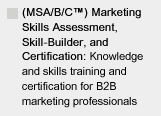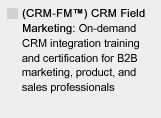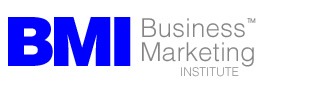MAKE SURE YOU CONTINUE TO RECEIVE EACH ISSUE OF TUESDAY MARKETING NOTES—CLICK HERE TO RENEW YOUR FREE SUBSCRIPTION
Quick and Dirty Market Testing:
Using Try-Test-Assess to Boost Response, Reduce Risk, and Diversify Your Marketing Program
By Eric Gagnon
Marketing people, like most of us in business, tend to think statically. We tend to view our marketing programs as the same series of linear events we’ve been working on for the past several years: The ad schedule in publications A, B, and C. The mailing of package D to lists E, F, and G. Running the same promotions with the same trade shows. All of these activities work fine, until demand falls or a competitor cuts their price or a much larger company enters the market to compete with you.
Getting along in a stable environment is fine as long as stability lasts. But in today’s flaky economy, and with the declines occurring in the effectiveness of older media like print trade publication advertising and the rapid transformation in business marketing from push (run the ad and readers will remember us) to demand-pull (your prospects use the Internet to search for products of interest, lining up potential suppliers who may or may not include your company), marketers need to get ahead of these challenges by getting above their marketing plans.
When the tried-and-true stops working—when prospects stop responding to your ads or your mailing program, or when price pressure, economic or other factors cause your market to go soft—that’s where flexibility, testing and bold experimentation pay off.
Flexibility and the willingness to try, test, and assess several new and different marketing activities can save a marketing program or increase sales in a changed market:
Try as many new and innovative activities as possible in your marketing program, on a small scale;
Test each of these new activities for the sales response (i.e., sales leads) generated, and
Assess your results through measurement, scale up the programs that work, kill the ones that don’t, or change the ones that may yield better response with improvement, and repeat
Thinking dynamically and not statically improves your marketing program, and “try-test-assess” helps you build a better, more responsive marketing program.
Trial-Test-Assess Mitigates Risk on Big Marketing Decisions
Another common scenario marketers face is making a big decision on an expensive new marketing campaign. For example, you may be under pressure to run an expensive new advertising or direct mail program to amplify your company’s presence in its market. Feeling forced to push the button on a big advertising buy using an unproven creative approach is completely unnecessary when these programs can be tested first, at much lower cost.
As marketers, none of us can honestly claim to know how, or how well, potential prospects will respond to any marketing activity. Trying a variety of approaches, and testing and measuring each one, gives you the insight you need to diversify your marketing program against a potential downturn in sales response, and mitigates the risk of making big marketing decisions by giving you a rough picture of sales response from the small-scale test before you roll it out as a major marketing program.
Try-test-assess transforms your marketing into a dynamic plan that adapts to changes in your market and stands ready to exploit new business opportunities. It is also the prudent approach to every major new marketing project that makes your marketing program an investment in business growth, and not a series of roll-the-dice marketing activities based on gut instincts.
Putting Try-Test-Assess to Work in Your Marketing Program
The best way to inform yourself prior to making big marketing decisions, or to “buy some insurance” in case your current marketing program goes soft, is to run an active try-test-assess marketing schedule alongside your current marketing plan, as a series of small, side-pocket marketing activities.
Examples of these activities would include testing new promotional offers and copy approaches to your current prospect database, developing and testing new mailing lists, and starting new initiatives, such as developing marketing programs built around “show what you know” information deliverables, to build the case for your company among active, interested Internet searchers looking for products or services like yours.
The good news is that most of the marketing activities you can use to try-test-assess many different new aspects in your marketing program are easy to implement, fairly cheap, and highly measurable. Best of all, since many of these testing activities can tell you much about your market, they can also make you a more well-informed and more effective marketing professional.
Here are a few examples:
Direct mail tests: Direct mail is the best marketing method for trying and testing new copy approaches, price options, and promotional offers, or virtually any other key element of your marketing program. Simple “A/B split” tests of one element, copy approach, or offer against another to the same list, for example, provides solid intelligence you can use as you make important decisions on how to present, price, position, and sell your product;
Google AdWords: AdWords test ads are an inexpensive, easy, fast way to get immediate feedback on basic sales headline and copy approaches, special offers, and information-based premium lead generation programs. While the volume of response for AdWords may not be high for specialized keywords used in many B2B markets, the differences you see generated by even a small number of clicks and conversions can give you a handle on which copy approaches or offers work better than others. Best of all, you can use this feedback and apply the winning copy approaches to other marketing activities, such as print advertising or direct mail;
Print Advertising: While print advertising is not generally thought of as being a flexible or fast acting marketing medium for testing, you can use fractional-page ads, especially fractionals with free promotional offers for white papers, etc., as a low-cost way to test response in new markets, and for testing different sales benefit and positioning approaches in your ad copy;
Quick new market response surveys: Thinking about launching your product into a new market? Develop “rough and ready” sales materials to test different copy approaches. In today’s digital world where a quick and decent-looking sales flyer, Web page, or fact sheet can be thrown together in under an hour, there’s no excuse for not trying this. Get these materials into the hands of your sales reps and business development people, who can get them in front of their key contacts in this new market for response and comment. A sales flyer or rough brochure makes a new product or a presentation of an existing product to a new market “real,” and what potential prospects and other key contacts in a new market tell you about your copy, your price point, and the other big questions which arise from this test can save you from big, dumb, expensive marketing mistakes down the line;
Testing in Lead Development: You can try-test-assess new copy approaches in marketing deliverables, new promotions, pricing/discount offers and other key variables with leads already in your sales pipeline and part of your lead development program. Better yet, if your company is using a CRM system, you can track response to these tests and quickly scale up those tests generating good response
Before You Make a Big Marketing Decision, Try-Test-Assess it First
Each and every one of these approaches can also be used to test copy, positioning, and promotional approaches before you commit big dollars out of your marketing budget to a major marketing initiative, such as a print advertising or direct mail campaign, a major product launch, or new market entry.
Every other operating arm of your company, from manufacturing to operations, IT, and finance, has its own methods to test and assess new processes, procedures and initiatives, yet most companies make their big marketing decisions on nothing more than wild guesses and smooth presentations. In a day where technology helps us execute faster than ever, there’s little time lost in testing most marketing programs at a smaller scale before ramping up. As marketers, we are being held to account for these decisions by showing a return on our marketing programs, so there is no excuse for not trying, testing, and assessing before we push the button on the next big, expensive marketing initiative.
Try-Test-Assess on Many Fronts is Your Best Hedge Against Failure
Try-test-assess does not have to be an elaborate, formal, or expensive testing program. Just keep the pot stirring by running a few small test activities each month—a targeted mailing with a new promotional offer or copy approach to a few dozen (or hundred) prospects, a fractional-page ad promoting a new white paper or applications case study, or a Google AdWords keyword search test to work out new headline approaches or information premium concepts.
This try-test-assess mindset should become both an ongoing part of your daily marketing activities, and a reflex response to any proposed major marketing expense: “Sounds like a good idea—let’s test it!” Factoring in enough lead time and the small expense required to test every big marketing move on a small scale enables you to test it beforehand without losing momentum.
Aside from insuring against program failure and mitigating risk, the other side benefit to try-test-assess helps you develop the agility required to adapt to changes in your market, by increasing your ability to execute and to think more dynamically about how you approach your market, through your marketing program.
Comments? Questions? Send them to me at: eric@businessmarketinginstitute.com
Eric Gagnon (eric@businessmarketinginstitute.com), a director with the Business Marketing Institute, is author of The Marketing Manager’s Handbook and The CRM Field Marketing Handbook.







